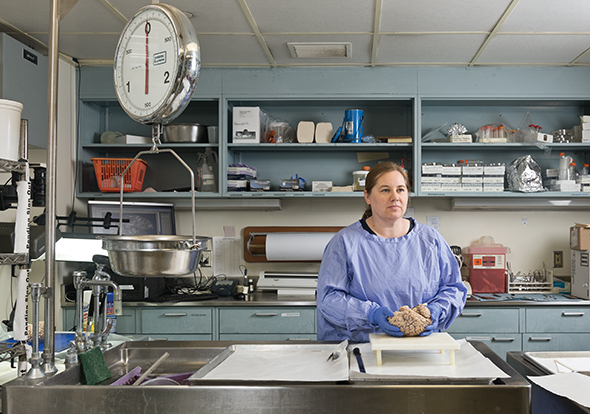The truth the dead know
Fall 2017

At 15, Gina Rugari was like a lot of girls her age: She liked manicures, sleepovers, and school dances. She loved her dog, Bella Rina, and dreamed of traveling to Paris. In other ways, though, Gina was atypical. She was born with Krabbe disease, a neurological disorder that might have taken her life before she turned 1. Instead—thanks to a medical breakthrough—she lived another 14 years.
When Gina died in 2015, her mother, Anne Rugari, donated Gina’s brain and spinal cord to be used for research at the University of Pittsburgh. That gift has advanced research on Krabbe disease, which causes depletion of myelin in the brain’s white matter and in the spinal cord. Eventually, nerves in those regions can no longer conduct electrical impulses normally, and they die.
“Gina had such a unique brain,” says Rugari. “She was one of the first infants to get an umbilical cord blood transplant for Krabbe disease, so I knew that when she passed away, it would be very valuable for researchers to have it.”
Gina’s tissue was housed and examined at Pitt’s Neuropathology Brain Bank. Rugari donated Gina’s tissue through the Program for the Study of Neurodevelopment in Rare Disorders at Children’s Hospital of Pittsburgh of UPMC. Julia Kofler, director of the Brain Bank, often hears from families directly: “At least once a week, someone contacts me and asks me about donating.
“People want to know more about what happened to their loved ones, and they want to be helpful to research,” says Kofler (Res ’10), MD assistant professor of pathology at Pitt.
Kofler earned her medical degree in her native Vienna. She started her career as a physician in the emergency department who also researched the neurological damage that can occur in patients surviving a cardiac arrest.
“The brain is an extremely complex organ, and I’ve always been fascinated by it,” Kofler says. So fascinated, in fact, that she moved to the United States and completed another residency, this time focusing on neuropathology. In her role at the Brain Bank, Kofler makes characterized tissue available to labs throughout the world. Her staff includes a pathology fellow and pathology assistant; they are on call 24 hours a day, seven days a week, to perform autopsies.
Kofler’s neuro-colleagues here speak reverently about the service she provides. “Julia is a huge resource,” says Chris Donnelly, PhD assistant professor of neurobiology. “Having her expertise to help validate our research is really, really important. A lot of labs don’t have access to someone like that.”
Yet Pitt’s bank has often operated on a wing and a prayer. Grant funding for brain banks is hard to come by; the National Institutes of Health, for instance, offers limited direct funding for such repositories (though it does support banking for Alzheimer’s disease research). Kofler has often had to string together support from multiple sources—grants as well as various departmental and hospital funds—to run the repository.
So Kofler was thrilled last fall when she learned that Pitt’s bank had been selected to receive part of a Henry L. Hillman Foundation grant in support of the University’s Brain Institute. “It’s been a huge help and stabilizing factor for our financial situation and allowed us to expand our banking initiatives,” she says.
Most of the 1,600 specimens at the bank have come from participants in Pitt’s Alzheimer Disease Research Center. The repository also houses specimens representing amyotrophic lateral sclerosis (ALS), Parkinson’s disease, and pediatric neurodegenerative diseases, such as Krabbe. Kofler is now partnering with Pitt’s Brain Trauma Research Center to further studies on traumatic brain injury and chronic traumatic encephalopathy (CTE), the degenerative condition that has afflicted football players.
The existence of the bank—and the bonus of having a director who is also a neuropathologist—helped lure Donnelly here from Johns Hopkins University in 2015. Donnelly focuses on understanding ALS at the molecular level.
When Donnelly needs to validate what he’s seeing in his petri dish, he turns to Kofler. He recently, for instance, identified a defective cellular pathway in the stem cells of patients who have a mutation that leads to ALS. Donnelly wondered if this impaired pathway might also exist in ALS patients without the mutation. So he asked Kofler if she could find evidence of the defective channel in her ALS tissue samples. She did, including in tissue from some patients who did not have the mutation.
“It’s an ongoing study,” Donnelly says. “But what it potentially means is, if we can figure out a way to correct the problem with that pathway, we might find a way to treat subsets of patients who have this disease.”
Similar validation is building understanding of Krabbe disease. Gina’s brain and spinal tissue, for instance, confirmed what animal studies had shown: an umbilical cord blood transfusion can halt disease progression, but more so in the brain than in the peripheral nervous system. Gina’s peripheral system showed disease progression, and this is most likely why she died, notes Maria Escolar, Pitt associate professor of pediatrics. Escolar is director of the Program for the Study of Neurodevelopment in Rare Disorders and had been Gina’s doctor at Children’s Hospital since the girl was born.
Rugari now educates parents of children with Krabbe disease about brain donation to further Escolar’s research. To date, nine families have participated. Escolar expects those donations will offer insight as she probes for a potential new treatment.
The progress is gratifying to Rugari.
In addition to losing Gina, Rugari lost an infant son, Nicholas, to Krabbe disease. He died in 1987.
“I was told back then, 31 years ago, that Krabbe is so rare there’s never going to be any research, cure, or treatment for this disease,” she says.
“I just said, ‘No way.’”
Editor’s Note: For research on CTE, the Brain Bank is looking for tissue donors who were boxers, played football, served in the military, or experienced concussions. Call 412-624-9415.
